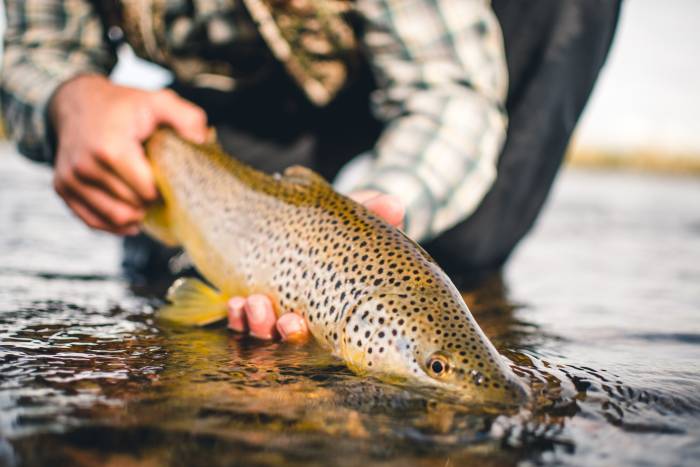These tips from a professional photographer will maximize your fly fishing photography efforts.
Fly fishing is an inherently beautiful sport. Whether you’re fishing for cutthroat in an alpine lake surrounded by dramatic cirques or stalking carp in a lowland prairie, there’s always a beautiful moment worthy of a photograph. Those moments capture the essence of why so many of us go fishing.
Often, photographs don’t do the scene justice. But with practice, the right gear, and a willingness to get out and adventure more, you can easily improve your fly fishing photos. The following tips will help you get out and produce more striking imagery every time you wet a line.
9 Fly Fishing Photo Tips
1. Go Fishing More

It’s simple: Capturing a great fly fishing photo often means that you happen to be in the right place at the right time. The more you fish, the more you’ll happen to find yourself in the incredible moments to photograph.
As your time in the field expands, you will clue in on aspects to shoot, like the way the last light of a day filters through the pines at a fishing hole or the precise moment of the annual hatch.
Fish more, learn your zones, and use the knowledge to your advantage. You’ll be prepared and ready when the moment presents itself.
2. Invest in a DSLR or Mirrorless Camera Body and Quality Lens
I primarily shoot on a Nikon D500. But there are many other entry-level camera bodies that work great and won’t break the bank. I used to shoot with a Nikon D5200, which you can find used online for less than $400.
While your camera body is important, it’s far more critical to have a nice lens. I shoot with an array of lenses ranging from 9 to 200 mm. My go-to lens is the Nikon 35mm f/1.8 prime lens. This lens is tack sharp and relatively affordable.
The large aperture creates a shallow depth of field and creamy bokeh and allows the photographer to shoot in low light without sacrificing shutter speed or cranking the ISO.
3. Shoot in Manual Mode

Cameras don’t take great photos — people do. I can’t stress enough how important it is to know the ins and out of your camera and all the settings. Shooting in manual forces you to truly understand the components of exposure. You can fine-tune your style and ultimately be completely in control of the final image.
Don’t be afraid to ask for help, and make sure you utilize YouTube for endless tutorials. Seriously, YouTube is amazing for that.
4. Strive for Strong Composition

The composition is key when taking a great fly fishing photograph. A well-composed image of an 8-inch dink trout sparks a greater emotional response for the viewer than a poorly composed image of a 30-inch brown trout.
Do your best to implement the rule of thirds. Avoid distracting backgrounds. Shoot from different perspectives. Lastly, seek out leading lines and strive to generate a sense of depth in your images.
In my opinion, the composition is hands down the most important component of a compelling photograph.
5. Mix It Up: More Than Just Grip & Grins

Fly fishing is a lifestyle. It’s about getting outdoors, seeing new things, and creating indelible memories with your friends. It’s about adventure and the pursuit of fish regardless of the outcome.
Don’t be afraid to shoot the entire fishing process.
Whether it’s rigging up, hiking into a sweet zone, casting, or sipping beers after a long day on the water, there are endless opportunities to photograph beautiful moments devoid of fish.
Every fly fisher gets skunked. Don’t let a quiet day deter you from busting out the camera when the fishing is slow.
6. Go Fishing With Rad People
I’m lucky enough to have an amazing girlfriend and a great group of homies who I fish with on a regular basis. If it wasn’t for them, I wouldn’t take nearly as many photos.

I still shoot when I fish by myself. There are many more opportunities to photograph compelling situations when there are multiple subjects and more going on.
7. Treat Your Camera as a Tool: Take Some Risks
Don’t be afraid to take your camera out in situations that are a bit risky. My favorite images are usually taken in dicey weather from the middle of a river.
I love shooting from low perspectives, and my camera gets splashed every now and then. I’m not suggesting that you be reckless with your gear: Be confident in calculated risks.
Try to push your comfort zone.
8. Seek Out Amazing Light
Nothing beats shooting in amazing light. Lucky for us, the best fishing often occurs when the sun is low on the horizon and golden rays illuminate the landscape.

Look for the interesting contrast in an exposure. Try to find scenarios where you can place a highlighted fly line against a shadowed backdrop.
You won’t be disappointed.
9. Respect the Fish
This is the most important thing to consider when taking a fly fishing image. If you’re planning on practicing catch-and-release, do your best to keep the fish as stress-free as possible.

Try to keep them wet, and if you do choose to pull the fish out for a grip and grin, only pull it out for a couple of seconds. And make sure to wet your hands before handling fish.
Benjamin Kraushaar is a professional photographer, videographer, and Kemmerer Fellow at the University of Wyoming. He pursues projects that use outdoor recreation as a vessel for science communication. Ben’s work can be viewed here.


